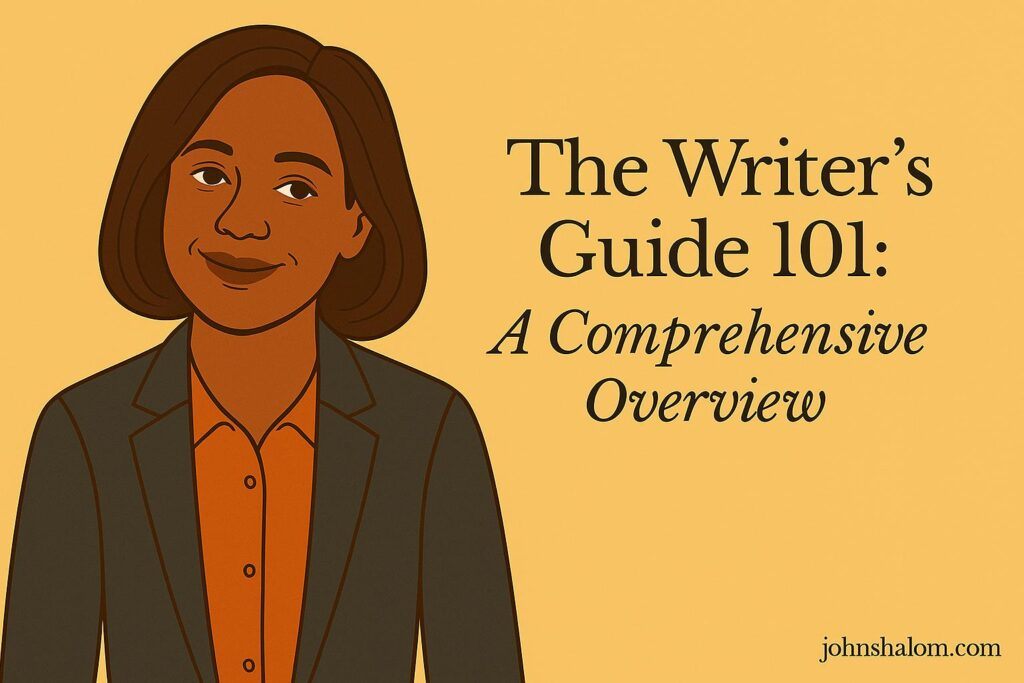
TL;DR:
Writing is both art and discipline. The Writer’s Guide 101 breaks it down—planning, drafting, editing, and publishing with clarity. It’s not just about words; it’s about strategy, consistency, and purpose. Every writer needs a map, and this guide is where that journey begins.
FAQs: The Writer’s Guide 101
1. What is The Writer’s Guide 101 about?
It’s a practical overview that teaches writers how to plan, write, edit, and publish effectively in today’s digital world.
2. Who can benefit from this guide?
Writers of all levels—beginners, bloggers, and authors—can use it to improve structure, productivity, and publishing success.
3. What key topics does it cover?
It focuses on writing habits, editing skills, publishing options, author branding, and long-term career growth.
4. How can this guide help new authors?
It offers step-by-step advice and encouragement, helping new writers avoid common mistakes and build confidence.
5. Why is The Writer’s Guide 101 essential?
Because it combines practical knowledge with creative inspiration—helping writers turn ideas into finished, impactful work.
Introduction
The Writer’s Guide 101 is a complete e-book designed to help aspiring and seasoned writers understand the fundamental aspects of writing, editing, publishing, and marketing their books. This book takes you through the history of writing, key writing concepts, and practical steps to becoming a successful author. Whether you are an aspiring novelist, a content writer, or an academic writer, this guide provides valuable insights into the world of writing.
Understanding Writing: Fiction vs. Non-Fiction
Fiction Writing
Fiction writing is all about creativity, storytelling, and imagination. Fictional works include novels, short stories, plays, and poetry. While the characters, settings, and events may be inspired by real life, they are often enhanced with creative elements to captivate readers. There are many genres in fiction, including:
- Mystery
- Thriller
- Romance
- Science Fiction
- Fantasy
- Historical Fiction
Non-Fiction Writing
Non-fiction writing is based on factual information. It is commonly found in:
- Academic writing (essays, research papers, textbooks)
- Biographies and autobiographies
- Self-help books
- Journalism (news articles, investigative reports)
- How-to guides (including this one!)
Writers must understand the distinctions between these two categories and choose a niche that best fits their strengths and interests.
The Importance of Editing in Writing
Editing is a crucial step in the writing process that ensures clarity, coherence, and professionalism. The editing phase involves:
- Structural Editing – Ensuring logical flow, chapter arrangement, and coherence in storytelling.
- Copy Editing – Checking for grammar, spelling, punctuation, and style consistency.
- Proofreading – Conducting a final review for typos and minor errors before publication.
- Formatting and Design – Adjusting fonts, spacing, and text alignment for readability.
Fiction and non-fiction books have different formatting styles. Fiction often has varied sentence structures and paragraph breaks for dramatic effect, while non-fiction emphasizes clarity and direct communication.
Publishing Your Work
Publishing has evolved significantly with digital advancements. Today, authors have multiple options for bringing their work to the public:
Traditional Publishing
- Requires submitting a manuscript to publishers or literary agents.
- Involves contracts, royalties, and possible advances.
- Provides professional editing, marketing, and distribution.
Self-Publishing
Self-publishing gives writers full control over their work. Popular platforms include:
- Amazon Kindle Direct Publishing (KDP) – Allows authors to publish e-books and paperbacks.
- Smashwords – Distributes e-books to multiple platforms.
- IngramSpark – A print-on-demand service with a wide distribution network.
Self-publishing is an excellent option for authors who want creative control and higher royalty rates.
You might also like: Self-Publishing Made Simple: From Manuscript to Marketplaces
Marketing Your Book
A well-written book deserves a strong marketing strategy to reach readers. Here are some effective book marketing methods:
Online Platforms
- Amazon KDP Select – Enroll books in Kindle Unlimited for greater visibility.
- Goodreads Author Program – Connect with readers and participate in book giveaways.
Social Media Marketing
- Promote books on Facebook, Twitter, Instagram, and LinkedIn.
- Use targeted ads and sponsored posts to reach potential readers.
Content Marketing
- Start a blog or website to showcase your expertise.
- Use email marketing to build a reader base and announce new releases.
Promotions and Discounts
- Offer free or discounted books for a limited time.
- Use coupon codes on platforms like Smashwords.
Conclusion
Becoming a successful writer involves more than just putting words on paper. It requires dedication to writing, meticulous editing, smart publishing decisions, and strategic marketing efforts. The Writer’s Guide 101 provides the knowledge and tools to help you navigate the writing world and achieve your literary goals.
Download the e-book now to start your journey as a writer!


